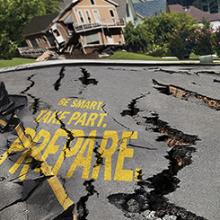This is the first in a short series of earthquake tips. If you live in an earthquake prone area, be sure to read and practice these guidelines. But even if you don’t live in California or Japan, these are still good skills to have just in case you or your loved ones travel to shaky spots. Make no mistake—there were plenty of visitors in San Francisco in 1906 when the big one hit.
Practice Drills
By planning and practicing what to do if an earthquake strikes, you and your family can learn to react correctly and automatically when the shaking begins. During an earthquake, most deaths and injuries are caused by collapsing building materials and heavy falling objects, such as bookcases, cabinets and heating units. Learn the safe spots in each room of your home. If you have children, get the entire family to practice going to these locations. Participating in an earthquake drill will help children understand what to do in case you are not with them during an earthquake.
Make sure you and your children also understand the school’s emergency procedures for disasters. This will help you coordinate where, when, and how to reunite after an earthquake.
During your earthquake drill:
- Get under a sturdy table or desk and hold on to it.
- If you’re not near a table or desk, cover your face and head with your arms; and
- stand or crouch in a strongly supported doorway OR . . .
- brace yourself in an inside corner of the house or building.
- Stay clear of windows or glass that could shatter or objects that could fall on you.
- Remember: If inside, stay inside. Many people are injured at entrances of buildings by falling debris.
Evacuation Plans
If an earthquake occurs, you may need to evacuate a damaged area afterward. By planning and practicing for evacuation, you will be better prepared to respond appropriately and efficiently to signs of danger or to directions by civil authorities.
- Take a few minutes with your family to discuss a home evacuation plan. Sketch a floor plan of your home; walk through each room and discuss evacuation details.
- Plan a second way to exit from each room or area, if possible. If you need special equipment, such as a rope ladder, mark where it is located.
- Mark where your emergency food, water, first aid kits, and fire extinguishers are located.
- Mark where the utility switches or valves are located so that they can be turned off, if possible.
- Indicate the location of your family’s emergency outdoor meeting place.
Establish Priorities
Take time before an earthquake strikes to write an emergency priority list, including:
- important items to be hand-carried by you
- other items, in order of importance to you and your family
- items to be removed by car or truck if one is available
- things to do if time permits, such as locking doors and windows, turning off the utilities, etc.
Write Down Important Information
Make a list of important information and put it in a secure location. Include on your list:
- important telephone numbers, such as police, fire, paramedics and medical centers
- the names, addresses, and telephone numbers of your insurance agents, including policy types and numbers
- the telephone numbers of the electric, gas and water companies
- the names and telephone numbers of neighbors
- the name and telephone number of your landlord or property manager
- important medical information, such as allergies, regular medications, etc.
- the vehicle identification number, year, model, and license number of your automobile, boat, RV, etc.
- your bank’s or credit union’s telephone number, account types and numbers
- radio and television broadcast stations to tune to for emergency broadcast information
Gather and Store Important Documents in a Fire-Proof Safe
- Birth certificates
- Ownership certificates (automobiles, boats, etc.)
- Social Security cards
- Insurance policies
- Wills
- Household inventory, including:
- list of contents
- photographs of contents of every room
- photographs of items of high value, such as jewelry, paintings, collectors’ items
It’s a good idea to keep photocopies of important documents in another place – maybe you can give them to a friend or relative you trust implicitly for safe-keeping – or keep a set in the bank.

